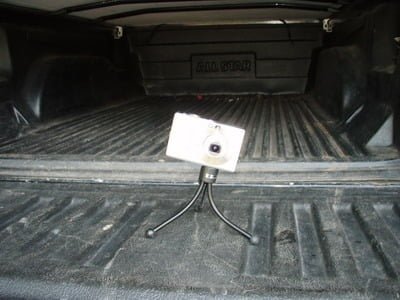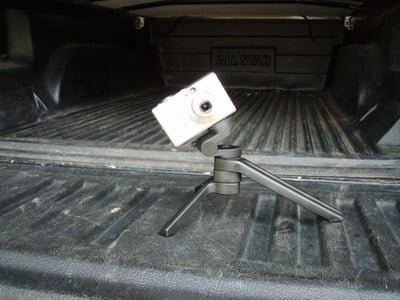People want to see pictures. In particular, when I go trout fishing, the Basswife wants to see where I have been and what I have caught. And, quite frankly, if I amaze the world and catch anything really good, I want to be able to brag a bit.
With digital cameras being so small, it’s certainly easy to haul them along on any fishing trip. The challenge is taking the picture.
When you look at many of the message boards, all you see is pictures of fish being held at arms length or the fish on the bank. While that may be good to post on the site if you are shy about showing yourself, you still need to have a picture or two of you holding your record catch. Given that trout fishing is usually a solitary activity with your buddies not being right next to you, this presents a problem since when you catch a fish, you are typically anxious to release it quickly. That’s where the need for a tripod comes in.
Once you have a tripod, you can pop you camera on it, activate the self timer and get that memory of a lifetime. The probelm is to find a tripod that is flexible enough to sit on a rock or other uneven surface as well as be small and light enough to carry.
I used to have a small tabletop tripod that finally rusted shut – so I was faced with the need to buy a replacement. I found the three versions you see to the right and ran a quick test to see which would be best suited to the hiking fisherman. The winner was the QT-10 pocket tripod.
QT-75 (far right in the picture): The first one I tested was a QT-75 that I found on discount. I discovered that it took a long time to screw the camera on since there is a spring loaded detent that will lock the camera in the vertical or horizontal position. You have to depress this with your finger on each rotation of the camera. With the pressure of getting a quick picture so you can release the fish, the extra time to do this was a huge negative. Then, I tried to imagine putting this on a rock. The three legs are fixed length, not adjustable and the rotating part at the top only moves in one direction – so you cannot compensate for a grossly uneven surface by turning the camera in any direction. Based on this, I concluded that this tripod was not a trail candidate – it was a great tripod for use in the home where you are not under time pressure and the environment is full of flat surfaces – just put it on a table and snap away using the self timer.
QT-10 (far left): This is a neat little tripod. It’s only about 5 inches tall and absolutely flexible as you can see from the picture below. It is easy to imagine sitting this on a rock or other uneven surface and then compensating to get the right shot by bending the legs. I looked to see if the camera would stay in position when the legs were adjusted and it seemed to be very steady and firm. Given this only costs 4 bucks, I decided to go with this one.
As you can see from the picture above, I also bought a traditional small tripod with adjustable legs and a mount that has 360 degree rotation which you can use to quickly compensate for an uneven surface just by rotating the camera to level it out. This tripod cost about 10 bucks at Best Buy. However, once I confirmed that the QT-10appeared to meet the requirements, I did not open it and took it back for a refund.

UPDATE based on Field Test; The QT-10is fine on hard rock surfaces. But if you put it on a soft surface – like the moss on top of a rock, it’s harder to get the camera adjusted properly. When you push it into position, it bounces back up a bit after you let it go as the moss expands when you let up on the pressure. Based on this, I think I may go back to the normal small tripod with the 360 swivel head like the one below. Once you get that situated, you can rotate the head, tighten the thumbscrew and not worry about any more movement.
There is also a website www.minitripods.com that has other options – but they are typically more expensive
With any tripod you need to do the following:
- Before you get into a “fish situation”, you need to know how to set the camera into the self timer mode without fumbling
- Quickly mount the camera to the tripod
- Push the self timer, pick up the fish and get the shot.
To do the above under a little less pressure, do not let the fish flop on the bank. Instead, after you remove the hook, put it back in your net and put the net in the water while you get the shot set up. With practice, you will find that you can get a picture in under a minute and send the fish on its way.

QT-10: Cheap, stable – thought it was the winner – but it only works well on a hard surface.
Unless stated otherwise, this article was authored by Steve Moore

QT-75. Fairly large and it did not seem like it was as adjustable as it needed to be. It was not ‘rock-friendly’

QT-10: Cheap, stable – thought it was the winner – but it only works well on a hard surface.
Unless stated otherwise, this article was authored by Steve Moore


